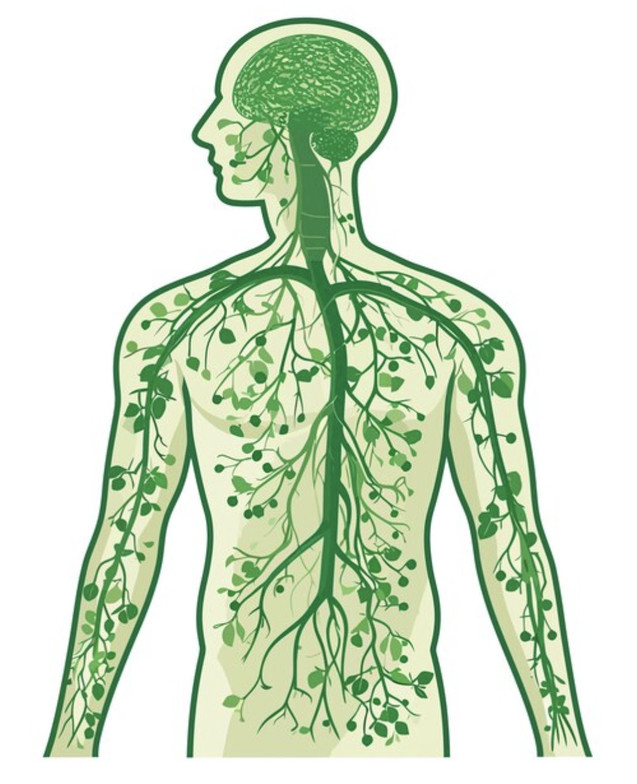
The importance of the lymphatic system, and its role in your everyday health, has been a hot topic in the health and wellness world in the past few years. But there are many of us that haven’t been looped in yet….

What is the lymphatic system?
In a basic sense, your lymphatic system is a set of tubes, organs, and tissues that contribute to your well being by maintaining fluid balance in the body, assisting with detoxification, supporting the immune system, and helping to absorb fat and fat soluble vitamins. It’s an open system, meaning that it flows in one direction, with one distinct entrance, and one distinct exit. These tubes transport excess water, cells, proteins, and certain fats (specifically long chain fatty acids) from each of the tissues in your body, and return them back to your central circulation (Cleveland Clinic, 2023). Your bone marrow and thymus act as primary lymphoid organs, which produce specialized cells for your immune system. Your spleen, tonsils, adenoids, lymph nodes, and various mucous membranes act as secondary lymphoid organs, which are the locations where these specialized immune cells do their job of fighting off germs and foreign substances (National Library of Medicine, 2023).
If you want to gain a deeper understanding of how the lymphatic system functions in relation to the rest of your body, it’s best to start with an overview of the circulatory system.

How does my circulatory system function?
In contrast to the lymphatics, the circulatory system functions as a closed system, meaning that blood flows in a continuous loop, which begins and ends at the heart. During this journey, blood works its way through the arteries to each of your tissues, supplying oxygen and nutrients via the capillaries. Simultaneously, carbon dioxide and other waste products produced by your tissues enter the bloodstream via the capillaries, and are transported through the veins. They are delivered up to the lungs, where they can be removed from the body through exhalation, or being filtered out by the kidneys. Fresh oxygen enters the blood through the lungs, which is then returned to the heart to be pumped back throughout the rest of your body (Cleveland Clinic, 2024). This continuous cycle provides our tissues with what they need to function properly, and removes a large portion of the waste they create. And the craziest part: this entire loop is completed every 20 seconds!
As you may have picked up thus far, the capillaries play a very important role in this cycle. But what’s so special about them?
The blood capillaries are semi permeable, meaning they allow certain molecules to pass through them into the interstitial space (the open space in between our cells/tissues), while other molecules are too large to pass in and out on their own. Each day, 20 liters of plasma exits the blood capillaries, which provides the body with the nourishment it requires to function properly. Roughly 17 liters of this plasma is filtered back out of the interstitial space by the venous capillaries, leaving 3 liters of fluid in the space surrounding your tissues (Cleveland Clinic, 2023). There are also plenty of cells that become free in the interstitial space (i.e. hematoma contents, red blood cells, white blood cells, cancer cells, bacteria, etc.), as well as proteins and long chain fatty acids. These things are all too large to be reabsorbed by the venous capillaries… This is where the lymphatic system comes into play.

If the lymphatic system wasn’t present, all of the excess fluid, cells, proteins, and fats would continue to accumulate, day after day, with nowhere to go. But, lucky for us, this build up causes a pressure gradient, which pulls the lymphatic capillaries open, allowing fluid to enter (and in this process, the fluid changes its name to “lymph”). Once inside, the lymph is transported through a variety of interconnected tubes that are segmented by valves, which help to maintain movement of fluid in one direction. These vessels are lined with smooth muscle that rhythmically contracts every 5-6 seconds on average (Von Der Weid 2003). This allows the lymph to slowly work its way up to its final destination, the subclavian vein, where it re-enters the circulatory system. On this journey, it passes through a variety of lymph nodes, where it’s filtered, trapping foreign particles to be addressed by the immune system. (Cleveland Clinic, 2023).
In this process, the lymphatic system helps to balance the fluid levels throughout the body, remove waste and other toxins that build up around your tissues, and provide the immune system the opportunity to defend against any bacteria, viruses, fungi, or parasites it may come across as lymph is filtered through your lymph nodes.
Now that we have a basic understanding of how the lymphatic system works, we can now discuss how to utilize it to maintain and improve your health and well being!
What would it look like if my lymphatic system wasn’t functioning optimally?
A poorly functioning lymphatic system will lead to a buildup of fluid, waste products, and toxins in the body.
The most widely understood deficiency of the lymphatic system is called lymphedema. This is when protein rich fluid begins to build up in the arms or legs due to damage to the lymphatic vessels. Lymphedema is a very common side effect after breast cancer treatments, but can occur for many other reasons (genetics, related to chronic venous insufficiency, post surgery, etc.). This condition is easy to identify, as it’s observable to the naked eye, but can be much more complicated to treat. The gold standard for managing this condition is to regularly consult with a professional certified in Complete Decongestive Therapy (CDT), which involves a combination of hands-on treatments, exercise, nutritional counseling, and compression wrapping (Lasinski 2013).
However, there are lots of conditions that can benefit from treatments directed to the lymphatic system, some of which may be more difficult to identify. More research in this area is needed, but current literature demonstrates relationships between a dysfunctional lymphatic system and chronic conditions such as rheumatoid arthritis, migraines, and post COVID-19 syndrome (Happe 2016; Overall 2023; Schwartz 2019). There are also numerous acute conditions, such as joint sprains and muscle strains, that cause inflammation that show favorable responses to treatments targeting the lymphatic system (Vairo 2009).
Ways to keep your lymphatic system functioning at its best:
- Drink plenty of water: Appropriate levels of hydration allow your lymph to travel smoothly through your body
- Move often throughout the day: Contractions of your muscles assist the nearby lymphatic vessels in transporting lymph; prolonged periods of sitting can make it more difficult for your lymphatic system to operate effectively
- Wear compression socks when at higher elevations: In situations where you find yourself at higher elevations (such as during air travel), the reduced air pressure makes it more difficult for the lymphatic system to absorb excess fluid. As a result, this can lead to swelling of the feet and ankles.
- Limit chemical exposure: Repeated or prolonged exposure to chemicals, such as pesticides or certain cleaning products, can lead to build up of toxins in your body over time, making it more difficult to filter waste
Is there anything else that can be done?
Yes!
For individuals who are not seeing improvements in their conditions, despite performing all of the basics highlighted above, there are certified professionals that can help.

Manual lymphatic drainage (MLD) is a manual manipulation of the skin that utilizes directional pressure to accelerate the rate of lymphatic flow and venous return. This technique was developed in the 1930 by Danish doctors Emil and Estrid Vodder, who utilized MLD to manage disorders of the immune system. MLD can be performed by a certified professional, and is an effective approach to reduce pain, prevent fluid build up, and promote relaxation. This technique can also help to rebalance the autonomic nervous system, as it promotes a general parasympathetic effect, reducing overall sympathetic activity. (Kim 2014). Effectively, this takes you out of the fight or flight state (we get it, life gets hectic), allowing you to enter into a state that’s more conducive for true healing.
Current research advocates for the use of manual lymphatic drainage to reduce symptoms, increase function, and improve quality of life for individuals dealing with chronic conditions such as autoimmune diseases, migraines, fibromyalgia, and post COVID-19 syndrome (Happe 2016; Kurt 2025; Overall 2023; Schwartz 2019).
Acute musculoskeletal injuries such as muscle strains, ankle sprains, and wrist fractures, have shown favorable responses to MLD in order to reduce inflammation (Vairo 2009). The reduction of local inflammation can help to reduce pain, restore mobility, and improve function.
Another area of application for manual lymphatic drainage is athletic recovery. MLD has been shown to accelerate skeletal muscle regeneration, decrease muscle soreness, and shorten recovery time in MMA athletes (Zebrowska 2019). This is a great option for competitive athletes looking to optimize their training effects.
Would I benefit from Manual Lymphatic Drainage?
It may be worthwhile to consider MLD if you're dealing with:
- Recent or persistent musculoskeletal injuries
- Autoimmunity, especially rheumatoid arthritis
- Migraines
- Long COVID
- Fibromyalgia
Or, are you a competitive athlete looking to optimize recovery and enhance training effects?
If you answered yes to any of these, or if you simply want to experience the benefits MLD can bring to your life, then it is certainly worth considering a consultation with a certified professional.
Ready to take the next step towards feeling your best?
If this information resonates with you and you’d like to get in touch, schedule a free consultation at Ebb and Flow Rehabilitation to get started.
Follow us on Facebook and Instagram for more content like this
References:
- Cleveland Clinic. (2024, September 4). How Your Circulatory System Works. Cleveland Clinic. https://my.clevelandclinic.org/health/body/circulatory-and-cardiovascular-system
- Cleveland Clinic. (2023, July 31). Lymphatic System. Cleveland Clinic. https://my.clevelandclinic.org/health/body/21199-lymphatic-system
- Happe, S., Peikert, A., Siegert, R., & Evers, S. (2016). The efficacy of lymphatic drainage and traditional massage in the prophylaxis of migraine: a randomized, controlled parallel group study. Neurological Sciences: Official Journal of the Italian Neurological Society and of the Italian Society of Clinical Neurophysiology, 37(10), 1627–1632. https://doi.org/10.1007/s10072-016-2645-3
- Kim, S.-J. (2014). Effects of Manual Lymph Drainage on the Activity of Sympathetic Nervous System, Anxiety, Pain, and Pressure Pain Threshold in Subjects with Psychological Stress. J Korean Soc Phys Ther, 26(6). https://klosetraining.com/wp-content/uploads/2020/03/Effects-of-MLD-on-Sympathetic-NS-2014.pdf
- Kurt, G., Kiloatar, H., Akdeniz Leblebicier, M., & Saraçoğlu, İ. (2025). Effects of manual lymphatic drainage on pain intensity, impact of disease and quality of life in women with fibromyalgia syndrome: a double-blind randomized sham-controlled trial. Disability and Rehabilitation, 1–7. https://doi.org/10.1080/09638288.2024.2449390
- Lasinski, B. B. (2013). Complete Decongestive Therapy for Treatment of Lymphedema. Seminars in Oncology Nursing, 29(1), 20–27. https://doi.org/10.1016/j.soncn.2012.11.004
- National Library of Medicine. (2023, August 14). What are the organs of the immune system? Nih.gov; Institute for Quality and Efficiency in Health Care (IQWiG). https://www.ncbi.nlm.nih.gov/books/NBK279395/
- Overall, B., Langley, K., & Douglass, J. (2023). Manual Lymph Drainage for Post-COVID-19 Related Cough, Breathlessness, and Fatigue; Two Case Reports. Healthcare, 11(23), 3085–3085. https://doi.org/10.3390/healthcare11233085
- Schwartz, N., Chalasani, M. L. S., Li, T. M., Feng, Z., Shipman, W. D., & Lu, T. T. (2019). Lymphatic Function in Autoimmune Diseases. Frontiers in Immunology, 10. https://doi.org/10.3389/fimmu.2019.00519
- Vairo, G. L., Miller, S. J., Rier, N. M. C. I., & Uckley, W. B. I. (2009). Systematic Review of Efficacy for Manual Lymphatic Drainage Techniques in Sports Medicine and Rehabilitation: An Evidence-Based Practice Approach. Journal of Manual & Manipulative Therapy, 17(3), 80E89E. https://doi.org/10.1179/jmt.2009.17.3.80e
- Von der Weid, P.-Y., & Zawieja, D. C. (2004). Lymphatic smooth muscle: the motor unit of lymph drainage. The International Journal of Biochemistry & Cell Biology, 36(7), 1147–1153. https://doi.org/10.1016/j.biocel.2003.12.008
- Zebrowska, A., Trybulski, R., Roczniok, R., & Marcol, W. (2019). Effect of Physical Methods of Lymphatic Drainage on Postexercise Recovery of Mixed Martial Arts Athletes. Clinical Journal of Sport Medicine, 29(1), 49–56. https://doi.org/10.1097/jsm.0000000000000485





